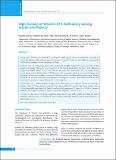Please use this identifier to cite or link to this item:
https://hdl.handle.net/20.500.14356/971Full metadata record
| DC Field | Value | Language |
|---|---|---|
| dc.contributor.author | Gyawali, Pratiksha | - |
| dc.contributor.author | Bhatt, Rajendra Dev | - |
| dc.contributor.author | Karmacharya, Robin Man | - |
| dc.contributor.author | Pant, Vivek | - |
| dc.contributor.author | Khadka, Ayesha | - |
| dc.date.accessioned | 2023-04-18T07:34:35Z | - |
| dc.date.available | 2023-04-18T07:34:35Z | - |
| dc.date.issued | 2022 | - |
| dc.identifier.citation | GyawaliP., BhattR. D., KarmacharyaR. M., PantV., & KhadkaA. (2023). High Burden of Vitamin B12 Deficiency among Adults and Elderly. Journal of Nepal Health Research Council, 20(3), 702-707. https://doi.org/10.33314/jnhrc.v20i3.4407 | en_US |
| dc.identifier.issn | Print ISSN: 1727-5482; Online ISSN: 1999-6217 | - |
| dc.identifier.uri | http://103.69.126.140:8080/handle/20.500.14356/971 | - |
| dc.description | Original Article | en_US |
| dc.description.abstract | Abstract Background: Deficiency of vitamin-B12 is widespread. Adults and the elderly are particularly susceptible to vitamin-B12 deficiency. This study investigated the burden of vitamin-B12 deficiency and insufficiency among adults and the elderly attending a tertiary care hospital in Nepal. Methods: This is a retrospective chart review conducted at Dhulikhel hospital. We reviewed records of 1615 patients investigating Vitamin-B12 level (pmol/L) at the clinical biochemistry laboratory from laboratory management database MIDAS between June 2020 and December 2021. Vitamin-B12 level was measured using enzyme immunoassay in Abbott Architect i1000SR analyzer. The categorical variables are presented as frequency and percentage; and numerical variables as means and standard deviations, or median and Interquartile range. Pearson Chi-square test was used to determine association between categorical variables. Mann Whitney test and Kruskal Wallis H test were used to compare Vitamin-B12 level by categories. Results: There were 1454 participants of which 33.5% of the patients were deficient, 27.9% were borderline deficient, while 38.7% had adequate vitamin B12 levels. Young adults(170.4 pmol/L) had a lower median vitamin B12 level than middle-aged adults (183.7pmol/L) and the elderly population (247.9pmol/L) (P<0.001). Compared to females (186.7 pmol/L), males(171.9 pmol/L) had lower vitamin B12 level (P <0.05). Conclusions: The study revealed that a significant proportion of young adults, middle aged adults and elderly population visiting a tertiary care hospital of Nepal are having vitamin B12 deficiency and borderline deficiency of public health concern. Keywords: Adults; deficiency; elderly, vitamin B12. | en_US |
| dc.language.iso | en | en_US |
| dc.publisher | Nepal Health Research Council | en_US |
| dc.relation.ispartofseries | July-Sep, 2022;4407 | - |
| dc.subject | Adults | en_US |
| dc.subject | deficiency | en_US |
| dc.subject | elderly | en_US |
| dc.subject | vitamin B12 | en_US |
| dc.title | High Burden of Vitamin B12 Deficiency among Adults and Elderly | en_US |
| dc.type | Journal Article | en_US |
| Appears in Collections: | Vol 20 No 3 Issue 56 july-Sep, 2022 | |
Files in This Item:
| File | Description | Size | Format | |
|---|---|---|---|---|
| 4407-Manuscript-30779-1-10-20230314.pdf | 219 kB | Adobe PDF |  View/Open |
Items in DSpace are protected by copyright, with all rights reserved, unless otherwise indicated.
